Initial Learning Curve for Robot-Assisted Total Knee Arthroplasty in a Dedicated Orthopedics Center
Abstract
:1. Introduction
2. Materials and Methods
2.1. Study Population
2.2. Surgical Protocol
2.3. Complications
2.4. Statistical Analysis
3. Results
4. Discussion
5. Conclusions
Supplementary Materials
Author Contributions
Funding
Institutional Review Board Statement
Informed Consent Statement
Data Availability Statement
Conflicts of Interest
References
- Kayani, B.; Haddad, F.S. Robotic total knee arthroplasty: Clinical outcomes and directions for future research. Bone Jt. Res. 2019, 8, 438–442. [Google Scholar] [CrossRef] [PubMed]
- Cristea, S.; Predescu, V.; Dragosloveanu, S.; Cuculici, S.; Marandici, N. Surgical Approaches for Total Knee Arthroplasty; IntechOpen: London, UK, 2016; pp. 25–47. [Google Scholar] [CrossRef]
- Schwabe, M.T.; Hannon, C.P. The Evolution, Current Indications and Outcomes of Cementless Total Knee Arthroplasty. J. Clin. Med. 2022, 11, 6608. [Google Scholar] [CrossRef] [PubMed]
- Argenson, J.-N.; Boisgard, S.; Parratte, S.; Descamps, S.; Bercovy, M.; Bonnevialle, P.; Briard, J.-L.; Brilhault, J.; Chouteau, J.; Nizard, R. Survival analysis of total knee arthroplasty at a minimum 10 years’ follow-up: A multicenter French nationwide study including 846 cases. Orthop. Traumatol. Surg. Res. 2013, 99, 385–390. [Google Scholar] [CrossRef] [PubMed]
- Ollivier, M.; Parratte, S.; Lino, L.; Flecher, X.; Pesenti, S.; Argenson, J.-N. No benefit of computer-assisted TKA: 10-year results of a prospective randomized study. Clin. Orthop. Relat. Res. 2018, 476, 126. [Google Scholar] [CrossRef]
- Bourne, R.B.; Chesworth, B.M.; Davis, A.M.; Mahomed, N.N.; Charron, K.D. Patient satisfaction after total knee arthroplasty: Who is satisfied and who is not? Clin. Orthop. Relat. Res. 2010, 468, 57–63. [Google Scholar] [CrossRef]
- Choi, Y.-J.; Ra, H.J. Patient satisfaction after total knee arthroplasty. Knee Surg. Relat. Res. 2016, 28, 1. [Google Scholar] [CrossRef]
- Stoica, C.I.; Nedelea, G.; Cotor, D.C.; Gherghe, M.; Georgescu, D.E.; Dragosloveanu, C.; Dragosloveanu, S. The Outcome of Total Knee Arthroplasty for Patients with Psychiatric Disorders: A Single-Center Retrospective Study. Medicina 2022, 58, 1277. [Google Scholar] [CrossRef]
- Merle-Vincent, F.; Couris, C.M.; Schott, A.-M.; Conrozier, T.; Piperno, M.; Mathieu, P.; Vignon, É.; Osteoarthritis Section of the French Society for Rheumatology. Factors predicting patient satisfaction 2 years after total knee arthroplasty for osteoarthritis. Jt. Bone Spine 2011, 78, 383–386. [Google Scholar] [CrossRef]
- Bourne, R.B.; Chesworth, B.; Davis, A.; Mahomed, N.; Charron, K. Comparing patient outcomes after THA and TKA: Is there a difference? Clin. Orthop. Relat. Res. 2010, 468, 542–546. [Google Scholar] [CrossRef]
- Gunaratne, R.; Pratt, D.N.; Banda, J.; Fick, D.P.; Khan, R.J.K.; Robertson, B.W. Patient Dissatisfaction Following Total Knee Arthroplasty: A Systematic Review of the Literature. J. Arthroplast. 2017, 32, 3854–3860. [Google Scholar] [CrossRef]
- Klem, N.R.; Smith, A.; O’Sullivan, P.; Dowsey, M.M.; Schütze, R.; Kent, P.; Choong, P.F.; Bunzli, S. What Influences Patient Satisfaction after TKA? A Qualitative Investigation. Clin. Orthop. Relat. Res. 2020, 478, 1850–1866. [Google Scholar] [CrossRef] [PubMed]
- Hampp, E.L.; Chughtai, M.; Scholl, L.Y.; Sodhi, N.; Bhowmik-Stoker, M.; Jacofsky, D.J.; Mont, M.A. Robotic-arm assisted total knee arthroplasty demonstrated greater accuracy and precision to plan compared with manual techniques. J. Knee Surg. 2019, 32, 239–250. [Google Scholar] [CrossRef] [PubMed]
- Alesi, D.; Meena, A.; Fratini, S.; Rinaldi, V.G.; Cammisa, E.; Lullini, G.; Vaccari, V.; Zaffagnini, S.; Marcheggiani Muccioli, G.M. Total knee arthroplasty in valgus knee deformity: Is it still a challenge in 2021? Musculoskelet. Surg. 2022, 106, 1–8. [Google Scholar] [CrossRef] [PubMed]
- Shatrov, J.; Parker, D. Computer and robotic—Assisted total knee arthroplasty: A review of outcomes. J. Exp. Orthop. 2020, 7, 70. [Google Scholar] [CrossRef]
- St Mart, J.-P.; Goh, E.L. The current state of robotics in total knee arthroplasty. EFORT Open Rev. 2021, 6, 270. [Google Scholar] [CrossRef]
- Song, E.-K.; Seon, J.-K.; Yim, J.-H.; Netravali, N.A.; Bargar, W.L. Robotic-assisted TKA reduces postoperative alignment outliers and improves gap balance compared to conventional TKA. Clin. Orthop. Relat. Res. 2013, 471, 118–126. [Google Scholar] [CrossRef]
- Park, S.E.; Lee, C.T. Comparison of robotic-assisted and conventional manual implantation of a primary total knee arthroplasty. J. Arthroplast. 2007, 22, 1054–1059. [Google Scholar] [CrossRef]
- Haddad, F. Evolving techniques: The need for better technology. Bone Jt. J. 2017, 99, 145–146. [Google Scholar] [CrossRef]
- Technology, O.D. Medtech Marks First ROSA Surgery System Sale in U.S. Available online: https://www.odtmag.com/contents/view_breaking-news/2016-03-14/medtech-marks-first-rosa-surgery-system-sale-in-us/ (accessed on 12 October 2023).
- Li, T.; Badre, A.; Alambeigi, F.; Tavakoli, M. Robotic Systems and Navigation Techniques in Orthopedics: A Historical Review. Appl. Sci. 2023, 13, 9768. [Google Scholar] [CrossRef]
- Kayani, B.; Konan, S.; Ayuob, A.; Onochie, E.; Al-Jabri, T.; Haddad, F.S. Robotic technology in total knee arthroplasty: A systematic review. EFORT Open Rev. 2019, 4, 611–617. [Google Scholar] [CrossRef]
- Batailler, C.; Hannouche, D.; Benazzo, F.; Parratte, S. Concepts and techniques of a new robotically assisted technique for total knee arthroplasty: The ROSA knee system. Arch. Orthop. Trauma Surg. 2021, 141, 2049–2058. [Google Scholar] [CrossRef] [PubMed]
- Dennis, D.A.; Kittelson, A.J.; Yang, C.C.; Miner, T.M.; Kim, R.H.; Stevens-Lapsley, J.E. Does tourniquet use in TKA affect recovery of lower extremity strength and function? A randomized trial. Clin. Orthop. Relat. Res. 2016, 474, 69–77. [Google Scholar] [CrossRef] [PubMed]
- Dragosloveanu, S.; Dragosloveanu, C.; Petre, M.; Gherghe, M.E.; Cotor, D.C. The Impact of Tourniquet Usage on TKA Outcome: A Single-Center Prospective Trial. Medicina 2023, 59, 870. [Google Scholar] [CrossRef]
- Tai, T.-W.; Lin, C.-J.; Jou, I.-M.; Chang, C.-W.; Lai, K.-A.; Yang, C.-Y. Tourniquet use in total knee arthroplasty: A meta-analysis. Knee Surg. Sports Traumatol. Arthrosc. 2011, 19, 1121–1130. [Google Scholar] [CrossRef] [PubMed]
- Kayani, B.; Konan, S.; Huq, S.; Tahmassebi, J.; Haddad, F. Robotic-arm assisted total knee arthroplasty has a learning curve of seven cases for integration into the surgical workflow but no learning curve effect for accuracy of implant positioning. Knee Surg. Sports Traumatol. Arthrosc. 2019, 27, 1132–1141. [Google Scholar] [CrossRef]
- Sodhi, N.; Khlopas, A.; Piuzzi, N.S.; Sultan, A.A.; Marchand, R.C.; Malkani, A.L.; Mont, M.A. The learning curve associated with robotic total knee arthroplasty. J. Knee Surg. 2018, 31, 17–21. [Google Scholar] [CrossRef]
- Bolam, S.M.; Tay, M.L.; Zaidi, F.; Sidaginamale, R.P.; Hanlon, M.; Munro, J.T.; Monk, A.P. Introduction of ROSA robotic-arm system for total knee arthroplasty is associated with a minimal learning curve for operative time. J. Exp. Orthop. 2022, 9, 86. [Google Scholar] [CrossRef]
- Bell, C.; Grau, L.; Orozco, F.; Ponzio, D.; Post, Z.; Czymek, M.; Ong, A. The successful implementation of the Navio robotic technology required 29 cases. J. Robot. Surg. 2022, 16, 495–499. [Google Scholar] [CrossRef]
- Mahure, S.A.; Teo, G.M.; Kissin, Y.D.; Stulberg, B.N.; Kreuzer, S.; Long, W.J. Learning curve for active robotic total knee arthroplasty. Knee Surg. Sports Traumatol. Arthrosc. 2022, 30, 2666–2676. [Google Scholar] [CrossRef]
- Naziri, Q.; Cusson, B.C.; Chaudhri, M.; Shah, N.V.; Sastry, A. Making the transition from traditional to robotic-arm assisted TKA: What to expect? A single-surgeon comparative-analysis of the first-40 consecutive cases. J. Orthop. 2019, 16, 364–368. [Google Scholar] [CrossRef]
- Vanlommel, L.; Neven, E.; Anderson, M.B.; Bruckers, L.; Truijen, J. The initial learning curve for the ROSA® Knee System can be achieved in 6-11 cases for operative time and has similar 90-day complication rates with improved implant alignment compared to manual instrumentation in total knee arthroplasty. J. Exp. Orthop. 2021, 8, 119. [Google Scholar] [CrossRef] [PubMed]
- Shah, R.P.; Lauthen, D.; Geller, J.A.; Cooper, H.J. Average operative times for 1313 primary total hip arthroplasty and 1300 primary total knee arthroplasty over 39 months are roughly equal to Medicare attributed operative times. J. Arthroplast. 2019, 34, 1553–1556. [Google Scholar] [CrossRef] [PubMed]
- Halawi, M.J.; Mirza, M.; Osman, N.; Cote, M.P.; Kerr, J.M.; Huddleston, J.I. Quantifying surgeon work in total hip and knee arthroplasty: Where do we stand today? J. Arthroplast. 2020, 35, 1170–1173. [Google Scholar] [CrossRef] [PubMed]
- Marchand, K.B.; Ehiorobo, J.; Mathew, K.K.; Marchand, R.C.; Mont, M.A. Learning Curve of Robotic-Assisted Total Knee Arthroplasty for a High-Volume Surgeon. J. Knee Surg. 2022, 35, 409–415. [Google Scholar] [CrossRef]
- Weber, M.; Worlicek, M.; Voellner, F.; Woerner, M.; Benditz, A.; Weber, D.; Grifka, J.; Renkawitz, T. Surgical training does not affect operative time and outcome in total knee arthroplasty. PLoS ONE 2018, 13, e0197850. [Google Scholar] [CrossRef]
- Massé, V.; Cholewa, J.; Shahin, M. Personalized alignment™ for total knee arthroplasty using the ROSA(®) Knee and Persona(®) knee systems: Surgical technique. Front. Surg. 2023, 9, 1098504. [Google Scholar] [CrossRef]
- Selvanathan, N.; Ayeni, F.E.; Sorial, R. Incidence of soft tissue releases in robotic assisted cementless TKA with mechanical alignment and flexion gap balancing. Arthroplasty 2023, 5, 28. [Google Scholar] [CrossRef]
- Lonner, J.H.; Goh, G.S. Moving beyond radiographic alignment: Applying the Wald Principles in the adoption of robotic total knee arthroplasty. Int. Orthop. 2023, 47, 365–373. [Google Scholar] [CrossRef]
- Stulberg, B.N.; Zadzilka, J.D.; Kreuzer, S.; Kissin, Y.D.; Liebelt, R.; Long, W.J.; Campanelli, V. Safe and effective use of active robotics for TKA: Early results of a multicenter study. J. Orthop. 2021, 26, 119–125. [Google Scholar] [CrossRef]
- Lee, D.; Yu, H.W.; Kwon, H.; Kong, H.J.; Lee, K.E.; Kim, H.C. Evaluation of Surgical Skills during Robotic Surgery by Deep Learning-Based Multiple Surgical Instrument Tracking in Training and Actual Operations. J. Clin. Med. 2020, 9, 1964. [Google Scholar] [CrossRef]
- Pakkasjärvi, N.; Krishnan, N.; Ripatti, L.; Anand, S. Learning Curves in Pediatric Robot-Assisted Pyeloplasty: A Systematic Review. J. Clin. Med. 2022, 11, 6935. [Google Scholar] [CrossRef] [PubMed]
- Perazzini, P.; Trevisan, M.; Sembenini, P.; Alberton, F.; Laterza, M.; Marangon, A.; Magnan, B. The Mako™ robotic arm-assisted total hip arthroplasty using direct anterior approach: Surgical technique, skills and pitfals. Acta Bio-Medica Atenei Parm. 2020, 91, 21–30. [Google Scholar] [CrossRef]
- Hampp, E.L.; Sodhi, N.; Scholl, L.; Deren, M.E.; Yenna, Z.; Westrich, G.; Mont, M.A. Less iatrogenic soft-tissue damage utilizing robotic-assisted total knee arthroplasty when compared with a manual approach: A blinded assessment. Bone Jt. Res. 2019, 8, 495–501. [Google Scholar] [CrossRef] [PubMed]
- Jacofsky, D.J.; Allen, M. Robotics in arthroplasty: A comprehensive review. J. Arthroplast. 2016, 31, 2353–2363. [Google Scholar] [CrossRef]
- King, C.A.; Jordan, M.; Bradley, A.T.; Wlodarski, C.; Tauchen, A.; Puri, L. Transitioning a practice to robotic total knee arthroplasty is correlated with favorable short-term clinical outcomes—A single surgeon experience. J. Knee Surg. 2020, 35, 078–082. [Google Scholar] [CrossRef]
- Liow, M.H.L.; Goh, G.S.-H.; Wong, M.K.; Chin, P.L.; Tay, D.K.-J.; Yeo, S.-J. Robotic-assisted total knee arthroplasty may lead to improvement in quality-of-life measures: A 2-year follow-up of a prospective randomized trial. Knee Surg. Sports Traumatol. Arthrosc. 2017, 25, 2942–2951. [Google Scholar] [CrossRef]
- Aparisi Gómez, M.P.; Marcheggiani Muccioli, G.M.; Guglielmi, G.; Zaffagnini, S.; Bazzocchi, A. Particularities on Anatomy and Normal Postsurgical Appearances of the Knee. Radiol. Clin. N. Am. 2023, 61, 219–247. [Google Scholar] [CrossRef]
- Ali, M.; Phillips, D.; Kamson, A.; Nivar, I.; Dahl, R.; Hallock, R. Learning curve of robotic-assisted total knee arthroplasty for non-fellowship-trained orthopedic surgeons. Arthroplast. Today 2022, 13, 194–198. [Google Scholar] [CrossRef]
- Sarpong, N.O.; Herndon, C.L.; Held, M.B.; Neuwirth, A.L.; Hickernell, T.R.; Geller, J.A.; Cooper, H.J.; Shah, R.P. What is the learning curve for new technologies in total joint arthroplasty? A review. Curr. Rev. Musculoskelet. Med. 2020, 13, 675–679. [Google Scholar] [CrossRef]
- Teo, B.J.X.; Yeo, W.; Chong, H.-C.; Tan, A.H.C. Surgical site infection after primary total knee arthroplasty is associated with a longer duration of surgery. J. Orthop. Surg. 2018, 26, 2309499018785647. [Google Scholar] [CrossRef]
- Ravi, B.; Jenkinson, R.; O’Heireamhoin, S.; Austin, P.C.; Aktar, S.; Leroux, T.S.; Paterson, M.; Redelmeier, D.A. Surgical duration is associated with an increased risk of periprosthetic infection following total knee arthroplasty: A population-based retrospective cohort study. EClinicalMedicine 2019, 16, 74–80. [Google Scholar] [CrossRef] [PubMed]
- Peersman, G.; Laskin, R.; Davis, J.; Peterson, M.; Richart, T. Prolonged operative time correlates with increased infection rate after total knee arthroplasty. HSS J. 2006, 2, 70–72. [Google Scholar] [CrossRef] [PubMed]
- Knapp, P.W.; Nett, M.P.; Scuderi, G.R. Optimizing Total Knee Arthroplasty with ROSA® Robotic Technology. Surg. Technol. Int. 2022, 40, 289–296. [Google Scholar] [CrossRef] [PubMed]
- Motesharei, A.; Batailler, C.; De Massari, D.; Vincent, G.; Chen, A.F.; Lustig, S. Predicting robotic-assisted total knee arthroplasty operating time: Benefits of machine-learning and 3D patient-specific data. Bone Jt. Open 2022, 3, 383–389. [Google Scholar] [CrossRef]
- Khlopas, A.; Sodhi, N.; Sultan, A.A.; Chughtai, M.; Molloy, R.M.; Mont, M.A. Robotic Arm-Assisted Total Knee Arthroplasty. J. Arthroplast. 2018, 33, 2002–2006. [Google Scholar] [CrossRef] [PubMed]
- Shin, C.; Crovetti, C.; Huo, E.; Lionberger, D. Unsatisfactory accuracy of recent robotic assisting system ROSA for total knee arthroplasty. J. Exp. Orthop. 2022, 9, 82. [Google Scholar] [CrossRef]
- Dragosloveanu, S.; Petre, M.A.; Gherghe, M.E.; Nedelea, D.G.; Scheau, C.; Cergan, R. Overall Accuracy of Radiological Digital Planning for Total Hip Arthroplasty in a Specialized Orthopaedics Hospital. J. Clin. Med. 2023, 12, 4503. [Google Scholar] [CrossRef]
- Haffar, A.; Krueger, C.A.; Goh, G.S.; Lonner, J.H. Total Knee Arthroplasty with Robotic Surgical Assistance Results in Less Physician Stress and Strain Than Conventional Methods. J. Arthroplast. 2022, 37, S193–S200. [Google Scholar] [CrossRef]
- Scholl, L.Y.; Hampp, E.L.; de Souza, K.M.; Chang, T.-C.; Deren, M.; Yenna, Z.C.; Sodhi, N.; Mont, M.A.; Westrich, G.H. How does robotic-arm assisted technology influence total knee arthroplasty implant placement for surgeons in fellowship training? J. Knee Surg. 2020, 35, 198–203. [Google Scholar] [CrossRef]
- Tompkins, G.S.; Sypher, K.S.; Li, H.F.; Griffin, T.M.; Duwelius, P.J. Robotic Versus Manual Total Knee Arthroplasty in High Volume Surgeons: A Comparison of Cost and Quality Metrics. J. Arthroplast. 2022, 37, S782–S789. [Google Scholar] [CrossRef]
- Cool, C.L.; Jacofsky, D.J.; Seeger, K.A.; Sodhi, N.; Mont, M.A. A 90-day episode-of-care cost analysis of robotic-arm assisted total knee arthroplasty. J. Comp. Eff. Res. 2019, 8, 327–336. [Google Scholar] [CrossRef] [PubMed]
- Ong, K.L.; Coppolecchia, A.; Chen, Z.; Watson, H.N.; Jacofsky, D.; Mont, M.A. Robotic-Arm Assisted Total Knee Arthroplasty: Cost Savings Demonstrated at One Year. Clin. Outcomes Res. 2022, 14, 309–318. [Google Scholar] [CrossRef] [PubMed]
- Heinz, T.; Eidmann, A.; Anderson, P.; Weißenberger, M.; Jakuscheit, A.; Rudert, M.; Stratos, I. Trends in Computer-Assisted Surgery for Total Knee Arthroplasty in Germany: An Analysis Based on the Operative Procedure Classification System between 2010 to 2021. J. Clin. Med. 2023, 12, 549. [Google Scholar] [CrossRef] [PubMed]
- Cotter, E.J.; Wang, J.; Illgen, R.L. Comparative Cost Analysis of Robotic-Assisted and Jig-Based Manual Primary Total Knee Arthroplasty. J. Knee Surg. 2022, 35, 176–184. [Google Scholar] [CrossRef]
- Sousa, P.L.; Sculco, P.K.; Mayman, D.J.; Jerabek, S.A.; Ast, M.P.; Chalmers, B.P. Robots in the Operating Room During Hip and Knee Arthroplasty. Curr. Rev. Musculoskelet. Med. 2020, 13, 309–317. [Google Scholar] [CrossRef] [PubMed]
- Steffens, D.; Karunaratne, S.; McBride, K.; Gupta, S.; Horsley, M.; Fritsch, B. Implementation of robotic-assisted total knee arthroplasty in the public health system: A comparative cost analysis. Int. Orthop. 2022, 46, 481–488. [Google Scholar] [CrossRef]
- Stauss, R.; Savov, P.; Tuecking, L.R.; Windhagen, H.; Ettinger, M. Robotic-assisted TKA reduces surgery duration, length of stay and 90-day complication rate of complex TKA to the level of noncomplex TKA. Arch. Orthop. Trauma Surg. 2023, 143, 3423–3430. [Google Scholar] [CrossRef]
- Tompkins, G.S.; Sypher, K.S.; Griffin, T.M.; Duwelius, P.D. Can a Reduction in Revision Rates Make Robotic Total Knee Arthroplasty Cost Neutral with Manual Total Knee Arthroplasty at Ten-Year Follow-Up? An Episode Cost Analysis. J. Arthroplast. 2022, 37, S777–S781.e773. [Google Scholar] [CrossRef]
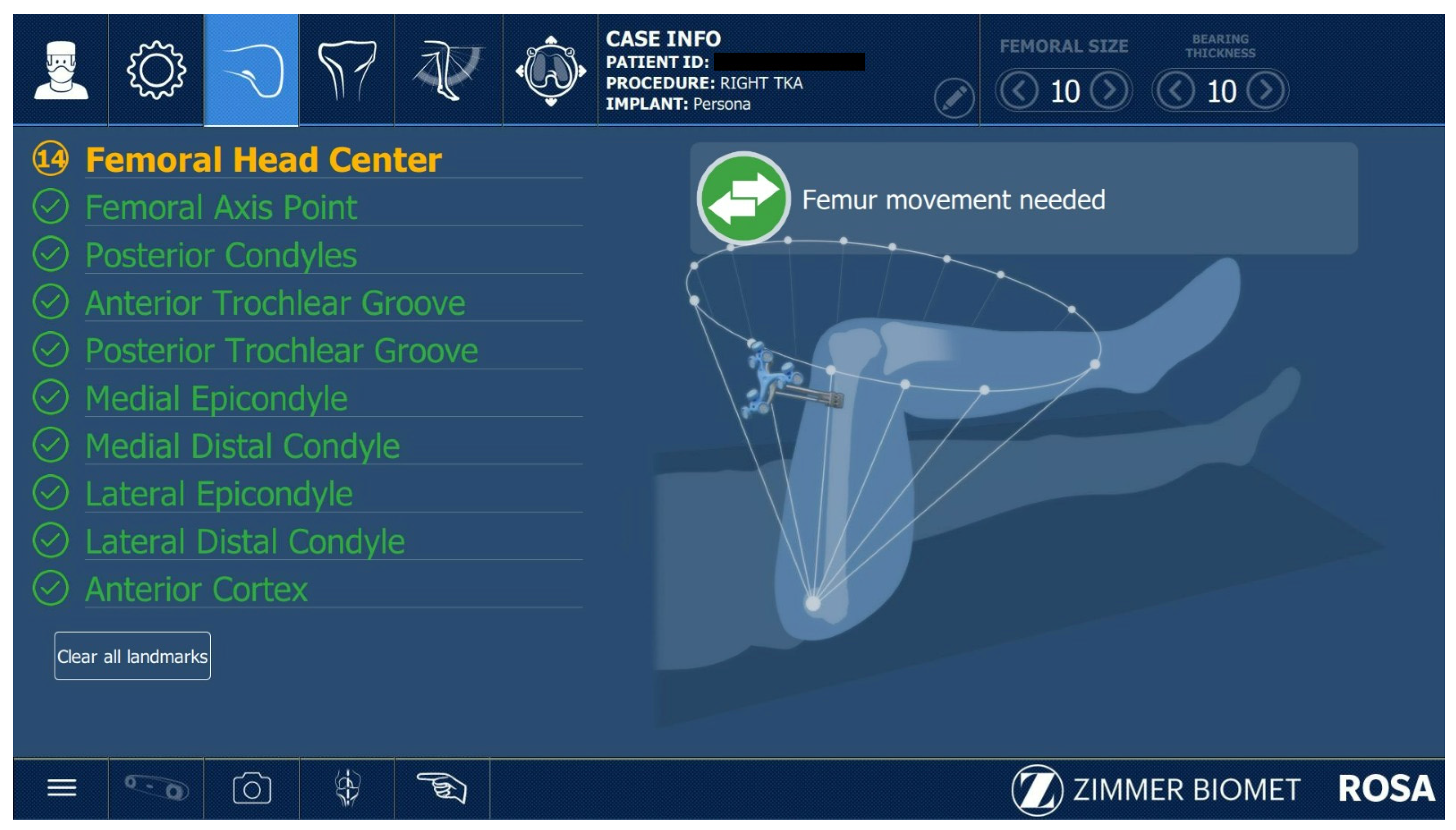

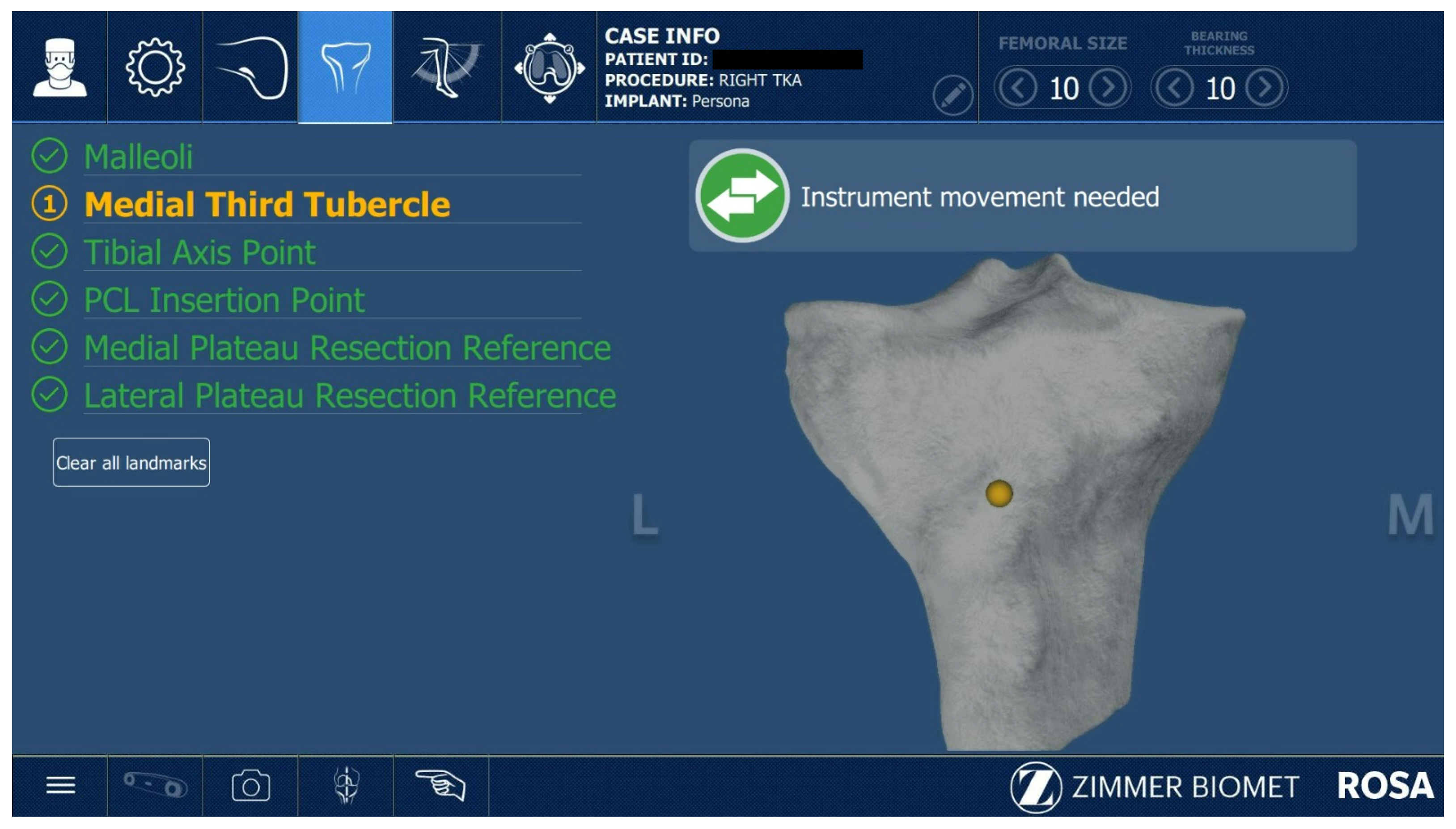
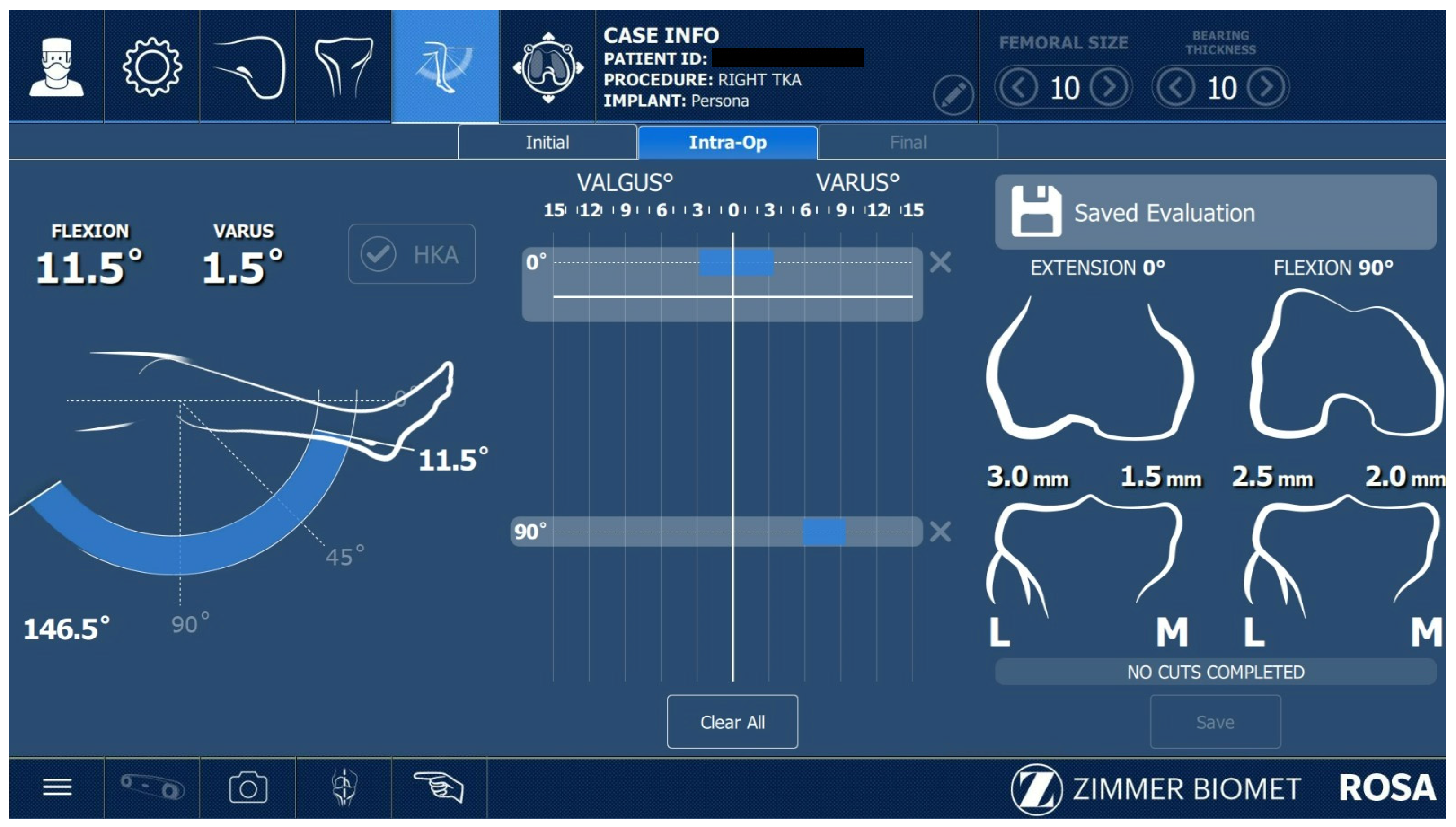
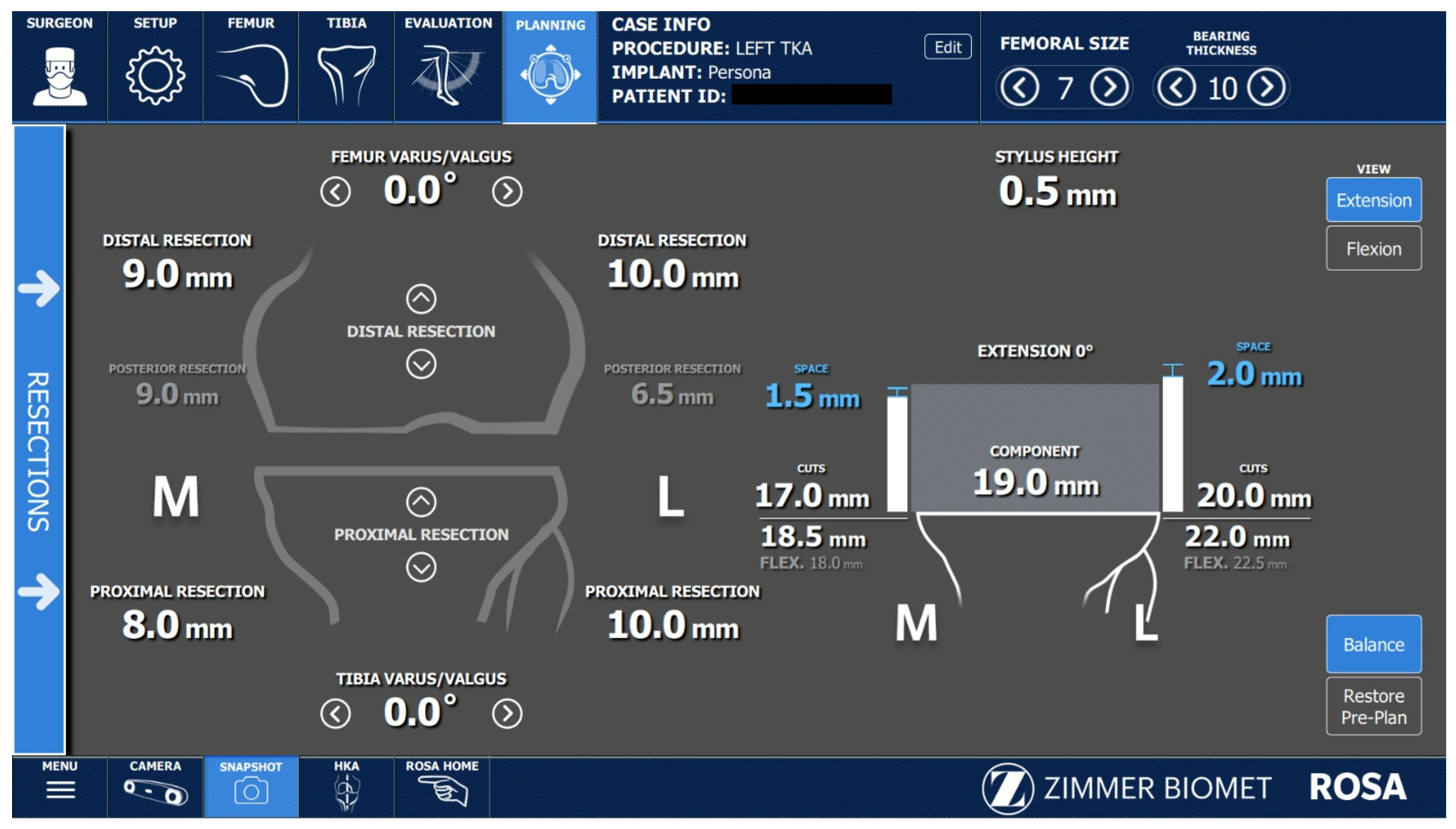

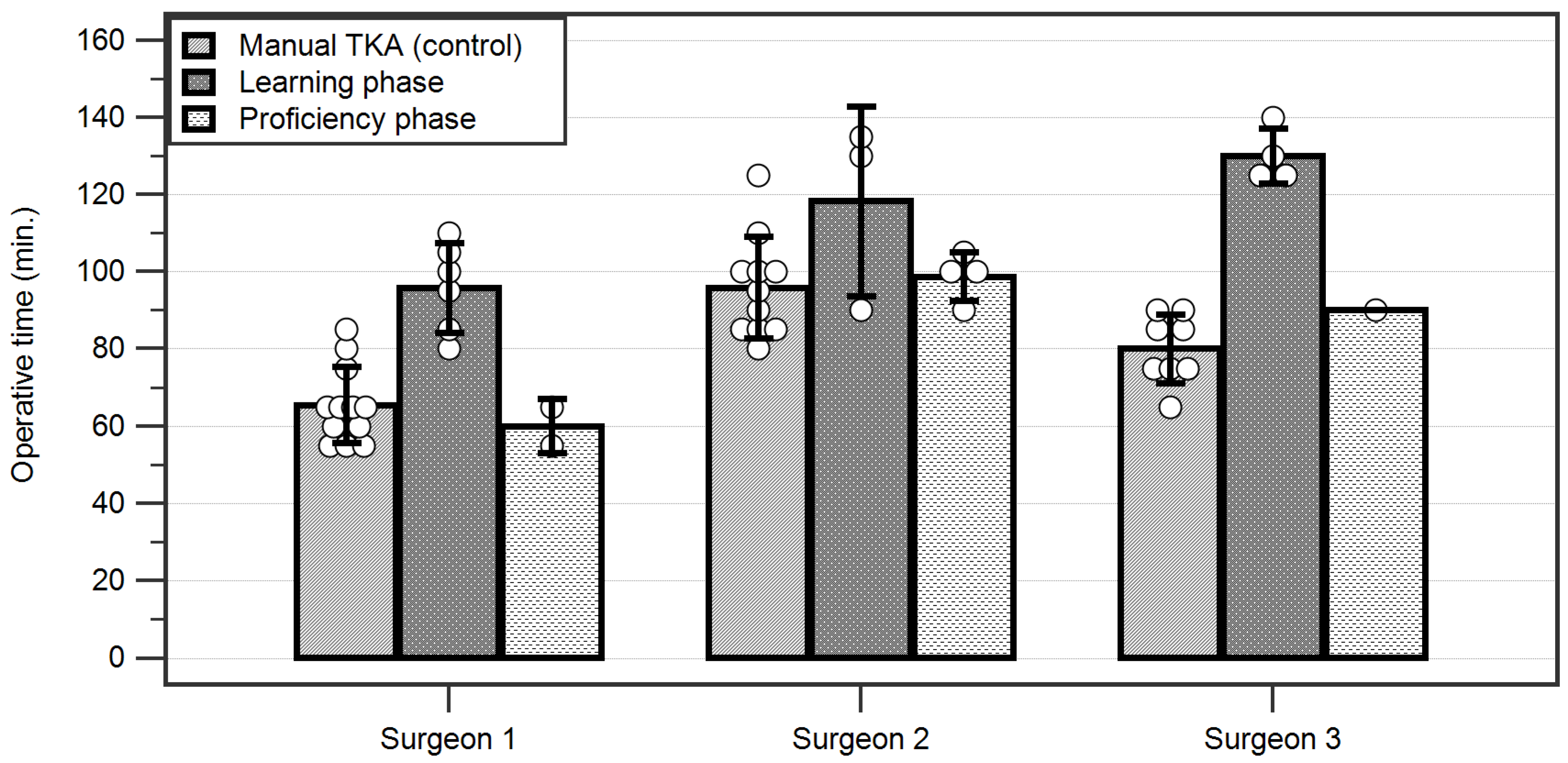
| Parameter | RA-TKA, n = 39 | Manual TKA, n = 45 | p-Value |
|---|---|---|---|
| Age (years) | 69.15 ± 5.24 | 67.22 ± 7.70 | 0.1896 |
| BMI (kg/m2) | 30.82 ± 4.95 | 30.11 ± 4.09 | 0.4770 |
| Sex (male/female) | 8/31 | 9/36 | 0.8306 |
| Laterality (left/right) | 18/21 | 23/22 | 0.8146 |
| Kellgren–Lawrence classification (percentage) | |||
| 3 | 15 | 18 | 0.9362 |
| 4 | 24 | 27 | |
| Limb alignment (number, HKA angle) | |||
| Varus | 39, 4.97 ± 2.27° | 39, 5.00 ± 2.36° | 0.9611 |
| Valgus | - | 6, 5.17 ± 2.27° | - |
| Parameter | Learning Phase | Proficiency Phase | Manual TKA | p-Value |
|---|---|---|---|---|
| Age (years) | 68.00 ± 5.49 | 69.71 ± 7.89 | 67.94 ± 7.71 | 0.835 |
| BMI (kg/m2) | 32.35 ± 5.33 | 30.91 ± 7.88 | 30.20 ± 4.03 | 0.432 |
| Sex (male/female) | 4/9 | 2/5 | 6/25 | 0.6778 |
| Laterality (left/right) | 6/7 | 2/5 | 15/16 | 0.6333 |
| Kellgren–Lawrence classification (percentage) | ||||
| 3 | 3 | 3 | 10 | 0.6519 |
| 4 | 10 | 4 | 21 | |
| Pre-operative varus (HKA) | 5.30 ± 2.53° | 5.85 ± 2.79° | 4.93 ± 2.40° | 0.663 |
| Operative time (minutes) | 111.54 ± 20.45 | 86.43 ± 19.09 | 80.56 ± 17.03 | <0.001 1 |
Disclaimer/Publisher’s Note: The statements, opinions and data contained in all publications are solely those of the individual author(s) and contributor(s) and not of MDPI and/or the editor(s). MDPI and/or the editor(s) disclaim responsibility for any injury to people or property resulting from any ideas, methods, instructions or products referred to in the content. |
© 2023 by the authors. Licensee MDPI, Basel, Switzerland. This article is an open access article distributed under the terms and conditions of the Creative Commons Attribution (CC BY) license (https://creativecommons.org/licenses/by/4.0/).
Share and Cite
Dragosloveanu, S.; Petre, M.-A.; Capitanu, B.S.; Dragosloveanu, C.D.M.; Cergan, R.; Scheau, C. Initial Learning Curve for Robot-Assisted Total Knee Arthroplasty in a Dedicated Orthopedics Center. J. Clin. Med. 2023, 12, 6950. https://doi.org/10.3390/jcm12216950
Dragosloveanu S, Petre M-A, Capitanu BS, Dragosloveanu CDM, Cergan R, Scheau C. Initial Learning Curve for Robot-Assisted Total Knee Arthroplasty in a Dedicated Orthopedics Center. Journal of Clinical Medicine. 2023; 12(21):6950. https://doi.org/10.3390/jcm12216950
Chicago/Turabian StyleDragosloveanu, Serban, Mihnea-Alexandru Petre, Bogdan Sorin Capitanu, Christiana Diana Maria Dragosloveanu, Romica Cergan, and Cristian Scheau. 2023. "Initial Learning Curve for Robot-Assisted Total Knee Arthroplasty in a Dedicated Orthopedics Center" Journal of Clinical Medicine 12, no. 21: 6950. https://doi.org/10.3390/jcm12216950
APA StyleDragosloveanu, S., Petre, M.-A., Capitanu, B. S., Dragosloveanu, C. D. M., Cergan, R., & Scheau, C. (2023). Initial Learning Curve for Robot-Assisted Total Knee Arthroplasty in a Dedicated Orthopedics Center. Journal of Clinical Medicine, 12(21), 6950. https://doi.org/10.3390/jcm12216950








